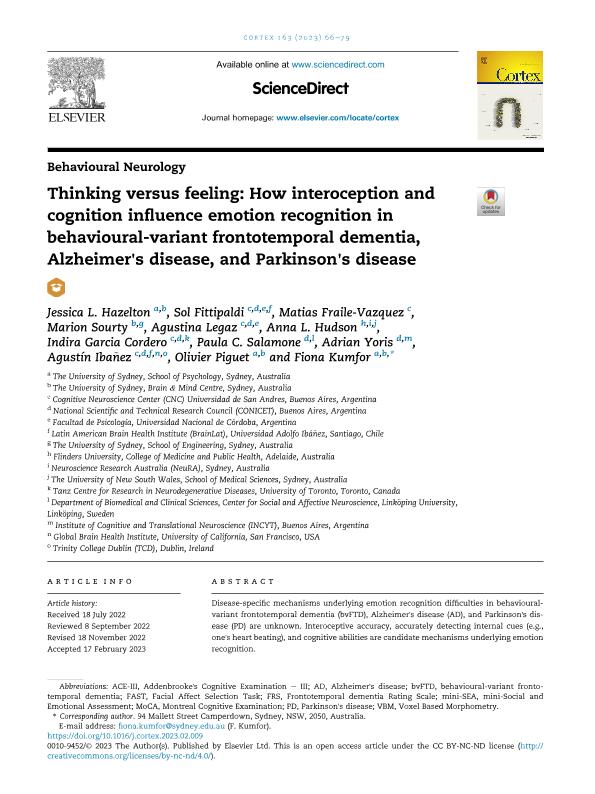Artículo
Thinking versus feeling: How interoception and cognition influence emotion recognition in behavioural-variant frontotemporal dementia, Alzheimer's disease, and Parkinson's disease
Hazelton, Jessica L.; Fittipaldi, María Sol ; Fraile Vazquez, Matias; Sourty, Marion; Legaz, Agustina
; Fraile Vazquez, Matias; Sourty, Marion; Legaz, Agustina ; Hudson, Anna L.; García Cordero, Indira Ruth
; Hudson, Anna L.; García Cordero, Indira Ruth ; Salamone, Paula Celeste
; Salamone, Paula Celeste ; Yoris, Adrián Isidro
; Yoris, Adrián Isidro ; Ibañez, Agustín; Piguet, Olivier; Kumfor, Fiona
; Ibañez, Agustín; Piguet, Olivier; Kumfor, Fiona
 ; Fraile Vazquez, Matias; Sourty, Marion; Legaz, Agustina
; Fraile Vazquez, Matias; Sourty, Marion; Legaz, Agustina ; Hudson, Anna L.; García Cordero, Indira Ruth
; Hudson, Anna L.; García Cordero, Indira Ruth ; Salamone, Paula Celeste
; Salamone, Paula Celeste ; Yoris, Adrián Isidro
; Yoris, Adrián Isidro ; Ibañez, Agustín; Piguet, Olivier; Kumfor, Fiona
; Ibañez, Agustín; Piguet, Olivier; Kumfor, Fiona
Fecha de publicación:
06/2023
Editorial:
Journal of Pure and Applied Algebra
Revista:
Cortex
ISSN:
0010-9452
Idioma:
Inglés
Tipo de recurso:
Artículo publicado
Clasificación temática:
Resumen
Disease-specific mechanisms underlying emotion recognition difficulties in behavioural-variant frontotemporal dementia (bvFTD), Alzheimer's disease (AD), and Parkinson's disease (PD) are unknown. Interoceptive accuracy, accurately detecting internal cues (e.g., one's heart beating), and cognitive abilities are candidate mechanisms underlying emotion recognition. One hundred and sixty-eight participants (52 bvFTD; 41 AD; 24 PD; 51 controls) were recruited. Emotion recognition was measured via the Facial Affect Selection Task or the Mini-Social and Emotional Assessment Emotion Recognition Task. Interoception was assessed with a heartbeat detection task. Participants pressed a button each time they: 1) felt their heartbeat (Interoception); or 2) heard a recorded heartbeat (Exteroception-control). Cognition was measured via the Addenbrooke's Cognitive Examination-III or the Montreal Cognitive Assessment. Voxel-based morphometry analyses identified neural correlates associated with emotion recognition and interoceptive accuracy. All patient groups showed worse emotion recognition and cognition than controls (all P's ≤ .008). Only the bvFTD showed worse interoceptive accuracy than controls (P < .001). Regression analyses revealed that in bvFTD worse interoceptive accuracy predicted worse emotion recognition (P = .008). Whereas worse cognition predicted worse emotion recognition overall (P < .001). Neuroimaging analyses revealed that the insula, orbitofrontal cortex, and amygdala were involved in emotion recognition and interoceptive accuracy in bvFTD. Here, we provide evidence for disease-specific mechanisms for emotion recognition difficulties. In bvFTD, emotion recognition impairment is driven by inaccurate perception of the internal milieu. Whereas, in AD and PD, cognitive impairment likely underlies emotion recognition deficits. The current study furthers our theoretical understanding of emotion and highlights the need for targeted interventions.
Archivos asociados
Licencia
Identificadores
Colecciones
Articulos(INCYT)
Articulos de INSTITUTO DE NEUROCIENCIAS COGNITIVAS Y TRASLACIONAL
Articulos de INSTITUTO DE NEUROCIENCIAS COGNITIVAS Y TRASLACIONAL
Citación
Hazelton, Jessica L.; Fittipaldi, María Sol; Fraile Vazquez, Matias; Sourty, Marion; Legaz, Agustina; et al.; Thinking versus feeling: How interoception and cognition influence emotion recognition in behavioural-variant frontotemporal dementia, Alzheimer's disease, and Parkinson's disease; Journal of Pure and Applied Algebra; Cortex; 163; 6-2023; 66-79
Compartir
Altmétricas



